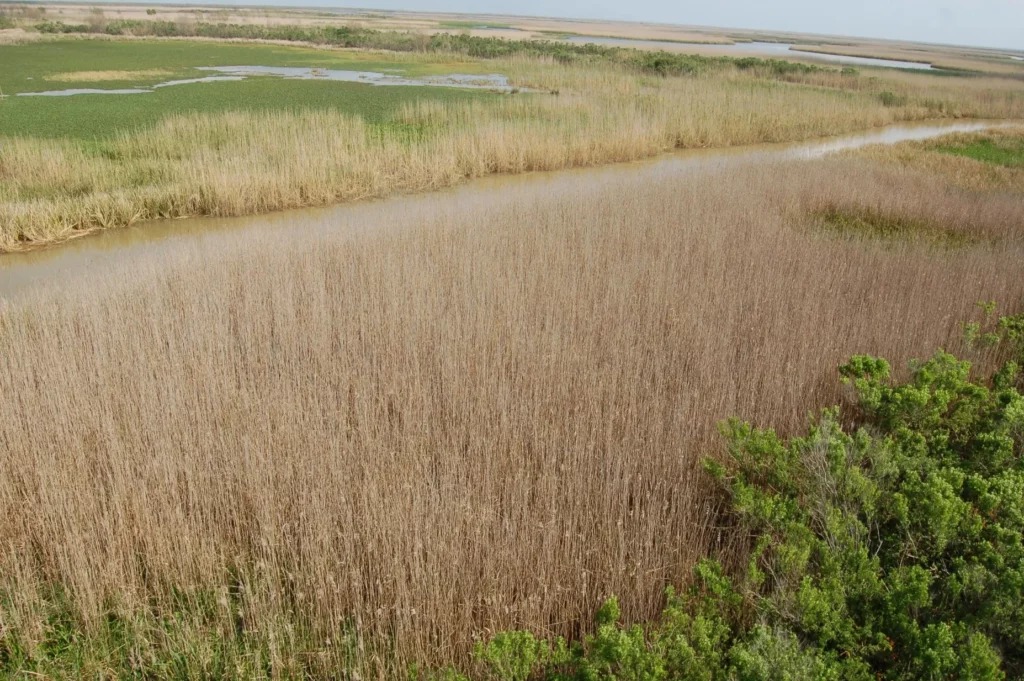Thick stands of roseau cane have died across the Louisiana coast in recent years. The sturdy, erosion-resistant reed is often replaced with weaker plants, such as water hyacinth, seen in the upper left of this photo, or shallow water. (Photo courtesy of the Louisiana Department of Wildlife and Fisheries)
Scientists say they have a new culprit for the mysterious mass die-off of a hardy plant that protects swaths of Louisiana’s fragile coast.
A study led by researchers at Louisiana State University indicates that increased exposure to saltwater has killed vast stretches of roseau cane, a towering reed that binds together large sections of south Louisiana, especially the lower Mississippi River Delta.
Scientists had previously pinned much of the blame on a tiny Asian insect that preys exclusively on roseau and appeared in the state around the time the plant began dying. But the bug, known as the roseau cane scale, only weakens the plant, according to the study published recently in Nature Communications.
The real killer may be a multipronged attack driven by climate change.
In the Gulf of Mexico, sea levels are rising at twice the global average, leading to prolonged inundation of coastal roseau wetlands. This extended submersion overwhelms the plants, exposing their roots to excessive salt levels that they can’t withstand, the study says.
The marshes are swamped with seawater “to a greater depth [and] a greater percentage of the time,” said Tracy Quirk, an LSU wetland scientist who led the study. “That makes them inherently more susceptible to acute disturbances, such as a drought, which allows saltwater to move in closer to the coast.”
While climate change is overdosing roseau with saltwater, it’s also starving it of freshwater. Roseau needs a mix of the two, but recent droughts have dramatically reduced river flows that would normally push out the stale saltwater.
Adding to roseau’s suffering are hurricanes that are hitting the Gulf Coast with more force, throwing salty surges across already weakened wetlands.
The scale, which sucks roseau’s sap, compounds the plant’s problems. But the insect likely isn’t the root cause of the plant dying off at an unprecedented rate in recent years, according to Quirk.
About the size of a grain of rice, the scale likely came to Louisiana aboard a ship from China, where the insect preys on various strains of roseau, known by scientists as phragmites. The scale spread fast over the past eight years, popping up in all of Louisiana’s coastal parishes and parts of Texas and Mississippi.
“Scale infestation causes a reduction in productivity” but does not cause an increase in mortality, the study said.
An LSU roseau cane research team visit a roseau restoration trial site in the Pass a Loutre Wildlife Management Area in Plaquemines Parish. (Joshua Snook/LSU AgCenter)
Disappearing roseau marshes may impede Mississippi River shipping, degrade habitat for redfish, crab and other coastal species and expose hundreds of oil wells to waves and storms, state officials say.
Roseau is critically important to Louisiana’s quickly unraveling coast because it both holds land in place and helps build new ground over time. The plant’s thick roots anchor the soil, helping it withstand erosion, while its densely packed stalks comb out river sediment, accumulating it to form new marshland.
In the roseau-dominated wetlands of Plaquemines Parish south of Venice, land has been reduced to open water in a matter of months. The die-off has been especially pronounced in the state’s Pass a Loutre Wildlife Management Area and the neighboring Delta National Wildlife Refuge, which are a combined 165,000 acres. About 80% of land in both wildlife areas has suffered severe roseau weakening or mortality between 2016 and 2018, according to state wildlife managers.
It’s unclear how much roseau marsh has disappeared, but some areas retreated by about 1,000 feet over a 16-month period, an analysis by the state Department of Wildlife and Fisheries found.
Using 16 years of data from a coastwide network of monitoring stations, the new LSU study showed roseau dying off in areas that went from being flooded with saltwater 43% of the year to 75% between 2007 and 2022.
“While drought-induced high salinities and soil saturation triggered a significant dieback event, the chronic increase in inundation is causing a longer-term decline in cover, more widespread losses, and reduced capacity to recover from acute stressors,” the study said.
The prognosis for roseau’s recovery isn’t good. Low rainfall in the upper Midwest caused two consecutive years of historically low water levels in the Mississippi. Such extremes are likely to become the norm as the global temperatures rise, according to LSU researchers.
“Extreme summer droughts are predicted to become more frequent in the future in response to climate warming,” the study said.
Quirk believes the resilience of roseau marshes could be improved by elevating marsh beds with redistributed river sediment, potentially via channels cut in levees. The state’s $3 billion Mid-Barataria Sediment Diversion, which broke ground last year, would function in this manner, but is too far north to help the hardest-hit roseau stands at the Mississippi’s mouth.
Another option would be to dredge sediment and add it directly to marshes – a strategy state and federal agencies employ on the coast, but not at a scale that matches the rate of land loss.
“In order to be more resilient, you have to deal with the flood stress and the only way to do that is to add sediment to these deteriorating marshes,” Quirk said.
SUPPORT NEWS YOU TRUST.
This article first appeared on Verite News and is republished here under a Creative Commons license.
The post New research blames climate change, not foreign bugs, for killing critical marsh grass appeared first on Louisiana Illuminator.

